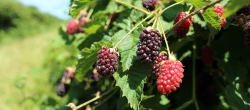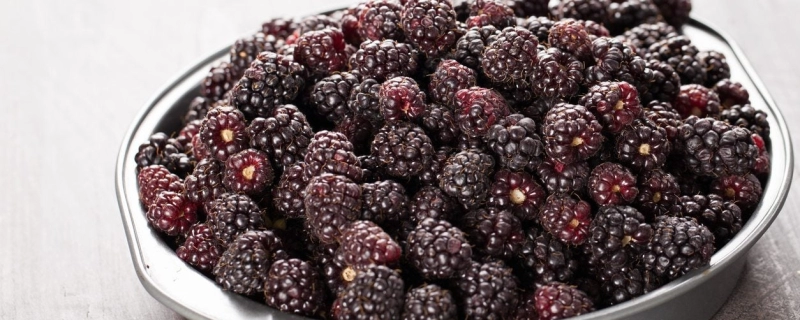Category: Fruits and Berries
Boysenberry: Taste, Uses, and Benefits
Boysenberry, a cross between a blackberry, raspberry, and loganberry, is a juicy, dark purple berry known for its sweet-tart flavor. Originating in California, this berry is popular for its unique taste and versatility in a wide range of culinary applications. Boysenberries are commonly used in jams, desserts, sauces, and more, bringing a rich berry flavor that is both refreshing and complex. This article explores the flavor characteristics of boysenberry, its culinary uses, health benefits, and tips for selecting and storing it.
What does Boysenberry taste like?
Primary Flavor Characteristics
Boysenberry has a distinctive sweet-tart taste that combines the juicy, full-bodied sweetness of blackberry with the bright, slightly tangy notes of raspberry. Its complex flavor profile makes it versatile for both sweet and savory dishes.
Aromatic and Taste Nuances
The aroma of boysenberry is intensely fruity, with earthy undertones and hints of sweetness. The taste is juicy and refreshing, with a slight tanginess that adds depth, making boysenberry a favorite for preserves, sauces, and fresh consumption.
Scientific Description of Taste and Aroma
- Aroma: Rich, fruity, with earthy and slightly sweet undertones.
- Taste: A blend of sweetness and tartness, similar to blackberry and raspberry.
- Texture: Juicy, with a tender flesh that is slightly seedy.

In-Depth Flavor Analysis of Boysenberry
Underlying Flavor Notes
Boysenberry’s flavor profile is complex, offering layers of sweetness, tartness, and subtle earthy qualities:
- Juicy Sweetness: Boysenberry has a pronounced natural sweetness that intensifies when fully ripe.
- Tangy Tartness: The berry’s slight tartness balances its sweetness, enhancing its refreshing quality.
- Earthy Undertones: Subtle earthy notes add depth to the flavor, making boysenberry stand out among other berries.
Impact of Ripeness on Flavor
- Under-ripe Boysenberry: Firmer and more tart, with less sweetness.
- Fully Ripe Boysenberry: Juicy, sweet, and tangy, with a perfect balance of flavors ideal for fresh eating.
- Over-ripe Boysenberry: Softer and sweeter, suitable for preserves and jams.
Textural Qualities
Boysenberry is known for its juicy, slightly seedy texture that bursts with flavor. The tender flesh is easy to bite into, providing a satisfying mouthfeel in both fresh and cooked applications.
Culinary Uses of Boysenberry
Primary Uses
- Jams and Preserves: Boysenberries are popular in jams and preserves due to their balanced sweetness and tartness.
- Desserts and Baking: The berry’s unique flavor enhances pies, tarts, muffins, and cakes.
- Sauces and Compotes: Boysenberry sauce pairs well with meats, pancakes, and ice creams, adding a fruity richness.
- Smoothies and Juices: Boysenberries bring a refreshing, vibrant taste to smoothies and juices.
- Fresh Consumption: The berries are often enjoyed fresh as a snack or added to fruit salads.
Ideal Pairings for Boysenberry
- Spices: Cinnamon and vanilla complement boysenberry’s sweetness in desserts.
- Citrus: Lemon and orange add brightness to boysenberry dishes, balancing its tartness.
- Chocolate: Dark chocolate enhances boysenberry’s earthy undertones in desserts.
- Dairy: Cream, yogurt, and cheese create a creamy contrast to boysenberry’s tangy flavor.
- Other Berries: Blueberries and strawberries add variety to boysenberry dishes, creating a rich berry medley.
Health Benefits of Boysenberry
Key Nutrients and Benefits
- Vitamin C: Boysenberries are high in vitamin C, supporting immune function and skin health.
- Fiber: The berry’s high fiber content aids digestion and helps maintain stable blood sugar levels.
- Antioxidants: Boysenberries contain antioxidants that help reduce inflammation and protect cells from oxidative stress.
- Vitamin K: This nutrient supports bone health and aids in blood clotting.
- Low Calorie: Naturally low in calories, boysenberries are a nutritious, refreshing option.
Potential Precautions
- Allergies: Individuals with sensitivities to berries may experience mild reactions to boysenberries.
- Delicate Nature: Boysenberries are highly perishable, so consume them quickly after purchase or freeze them for longer storage.

Tips for Choosing and Storing Boysenberries
How to Choose Quality Boysenberries
- Color and Firmness: Choose deep purple, plump berries that are slightly soft, indicating ripeness.
- Aroma: Fresh boysenberries have a sweet, fruity aroma, a sign of ripeness and quality.
Storage Recommendations
- Refrigeration: Store fresh boysenberries in the refrigerator, where they can remain fresh for 2–3 days.
- Freezing: For long-term storage, freeze boysenberries on a baking sheet before transferring them to an airtight container, preserving their flavor for several months.
- Use Quickly: Due to their delicate nature, boysenberries are best used soon after purchasing.
Fun Facts About Boysenberry
- Hybrid Berry: Boysenberry is a cross between blackberry, raspberry, and loganberry, combining the best qualities of each.
- California Origin: The berry was developed in California by horticulturist Rudolph Boysen in the 1920s.
- Knott’s Berry Farm: Boysenberries gained popularity when they were first commercially cultivated by Walter Knott of Knott’s Berry Farm.